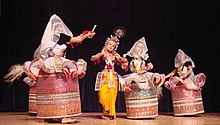The dance performed during the Raas mela festival is known as Raas Dance. The Raas Purnima festival is the most significant religious and cultural heritage celebration for the Manipuri indigenous community in Bangladesh. This festival is held annually on the full moon of Kartik (October-November). In celebration of the Raas festival, the Raas Dance is performed. This dance is an exquisite classical creation of Manipuri cultural heritage, portraying the visible form of invisible emotions.[1][2]

Background
editThe Raas Dance is divided into five categories: "Maha Raas," "Basanta Raas," "Kunja Raas," "Divya Raas," and "Nitya Raas." Among these, "Maha Raas" is the most grand and elaborate. As described in the fifth chapter of the Bhagavata Purana, the Maha Raas is performed in stages such as Krishna’s rendezvous with Radha, group gatherings, emotional exchanges of the gopis, Krishna’s dance, Radha’s dance, the gopis’ dances, Krishna’s disappearance, reappearance, floral tributes, and concluding with the return to their homes. In Raas Dance, the roles of Radha and Krishna are usually played by children under five years old.[3] The Manipuri community believes that after this age, children lose their divine aura. However, the primary dramatic performances and songs are presented by young women portraying Radha’s companions.[4] The central focus of Raas Dance is the "Bhangi Pareng," or the dance sequence.[2] The Raas Leela begins with Nata Sankirtan, performed by the artists in front of the deity’s idol in the grand temple pavilion of Govindaji. Accompanied by mridanga and cymbals, the artists perform Sankirtan, adorned in special attire. The event, lasting nearly five hours, begins with the invocation of Sri Krishna Chaitanya and continues with Raas songs. Through this dance, the devotional artists emotionally connect with Sri Krishna. The songs for the Raas Dance are drawn from the poetry of Bengali, Maithili, Brajabuli, and Meitei poets.[5][6]
Recognition
editManipuri dance was introduced to the outside world by the poet Rabindranath Tagore. During his visit to Sylhet in 1926, he was mesmerized by the delicate movements of this dance. Later, he incorporated its elements into his dance dramas.[7] The Manipuri community continues to celebrate Nata Sankirtan and Raas annually with devotion and festivity.[2][8]
See also
editReferences
edit- ^ "'Maha Raas Leela' Festival in Indigenous Villages". Manab Zamin. Retrieved 2024-11-24.
- ^ a b c "Lai Haraoba Practices 1". www.e-pao.net. Retrieved 2024-11-24.
- ^ "Raas Dance, Manipuri Dance, Raas Leela". www.onushilon.org. Retrieved 2024-11-24.
- ^ Report, Star (2024-11-17). "Raas festival ends amid festivity". The Daily Star. Retrieved 2024-11-24.
- ^ Tarafdar, Shimul (2022-11-09). "Maha Raas Leela". Prothomalo (in Bengali). Retrieved 2024-11-24.
- ^ "Raas Dance: Bringing the finest of Indian Culture to America!". thecultureties.com. 2024-07-08. Retrieved 2024-11-24.
- ^ "Manipuri's Maha Raas Leela to be held on November 2 in Kamalganj". 22 November 2009. Archived from the original on 31 October 2009. Retrieved 22 November 2009.
- ^ "Manipuri community's Raas Festival begins in Moulvibazar". The Business Standard. 2023-11-28. Retrieved 2024-11-24.